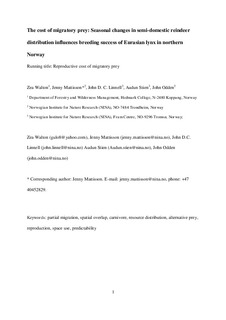The cost of migratory prey: seasonal changes in semi-domesticreindeer distribution influences breeding success of Eurasian lynx in northern Norway
Peer reviewed, Journal article
Permanent lenke
http://hdl.handle.net/11250/2422426Utgivelsesdato
2016Metadata
Vis full innførselSamlinger
- Publikasjoner fra CRIStin - NINA [2364]
- Scientific publications [1392]
Sammendrag
Migratory prey is a widespread phenomenon that has implications for predator – prey interactions. By creating large temporal
variation in resource availability between seasons it becomes challenging for carnivores to secure a regular year-round
supply of food. Some predators may respond by following their migratory prey, however, most predators are sedentary
and experience strong seasonal variation in resource availability. Increased predation on alternative prey may dampen such
seasonal resource fl uctuations, but reduced reproduction rates in predators is a predicted consequence of migratory primary
prey behavior that has received little empirical attention. We used data from 23 GPS collared Eurasian lynx Lynx lynx
monitored during 2007 – 2013 in northern Norway, to examine how spatio-temporal variation in the migratory behavior
of semi-domestic reindeer Rangifer tarandus infl uences lynx spatial organization and reproductive success using estimates
of seasonal home range overlap and breeding success. We found that lynx of both sexes maintained seasonally stable home
ranges and exhibited site fi delity across years, independent of whether they had access to reindeer throughout the year or
experienced a scarcity of reindeer in winter due to migration. However, lynx without access to reindeer in winter showed a
decreased probability of reproducing and a tendency for lowered kitten survival into their fi rst winter, when compared to
female lynx with reindeer available year around. Th is supports the hypothesis that sedentary predators experience demographic
costs in systems with migratory primary prey. Changes in the migratory behavior of ungulates, including disrupted
migrations, is therefore likely to have bottom – up eff ects on the population dynamics of sedentary predators as well as the
previously documented consequences for ungulate population dynamics.
